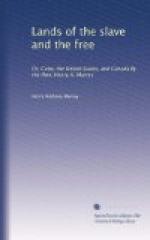I do not wish to pander to a morbid appetite for horrors by gathering together under one view all the various tales of woe and misery which I have heard of, known, or seen. I think I have said enough to prove to any unprejudiced person that such things do and must ever exist under the institution of slavery; and that, although the statements of rabid abolitionists are often the most unwarranted exaggerations, the all but total denial of their occurrence by the slave-owners is also not correct. The conviction forced upon my own mind, after much thought and inquiry on this most interesting topic is, that there are many dark clouds of cruelty in a sky which is bright with much of the truest and kindest sympathy for the poor slave.
I now propose to take a short review of the progress and real state of slavery, and I will commence by giving in extenso an enactment which materially affects the negro, and, as I have before observed, has more than once threatened the Republic with disunion:—
Section 2.—Privileges of Citizens.—Clause 3. “No person held to service or labour in one state under the laws thereof, escaping to another, shall in consequence of any law or regulation therein be discharged from such service or labour, but shall be delivered up on claim of the party to whom such service or labour may be due.”
Of course the word “slave” would have read strangely among a community who set themselves up as the champions of the “equal rights of man;” but it is clear that, according to this clause in the constitution which binds the Republic together, every free state is compelled to assist in the recapture of a fugitive slave.
What was the exact number of slaves at the date of this law being passed I have not the means of ascertaining: at the beginning of this century it was under 900,000; in the Census of 1850 they had increased to 3,200,000.[BT] There were originally 13 States. At present there are 31, besides territory not yet incorporated into States. The Slave States are 15, or nearly half. Thus much for increase of slaves and the slave soil. But, it will naturally be asked, how did it happen that, as the additional soil was incorporated, the sable workmen appeared as if by magic? The answer is very simple. The demand regulated the supply, and slave breeding became a most important feature in the system: thus the wants of the more southern States became regularly lessened by large drafts from Maryland, Kentucky, and Virginia. Anybody desirous of testing the truth of this statement will find statistical data to assist him in an unpretending volume by Marshall Hall, M.D., &c., On Twofold Slavery, which I read with much interest, although I cannot agree with him in everything.[BV]




